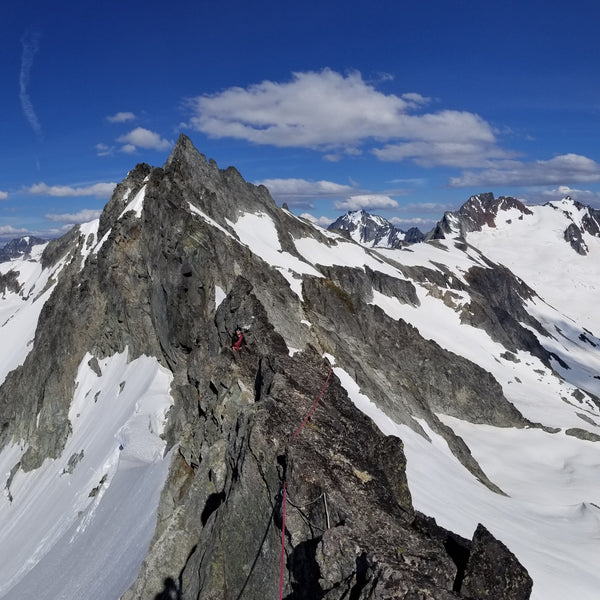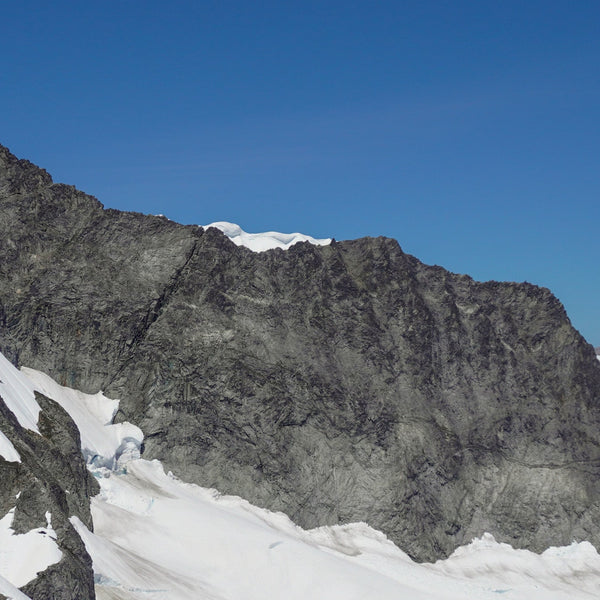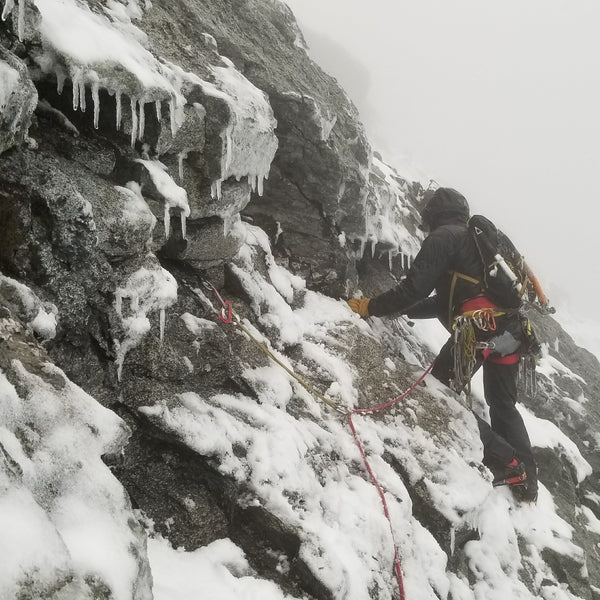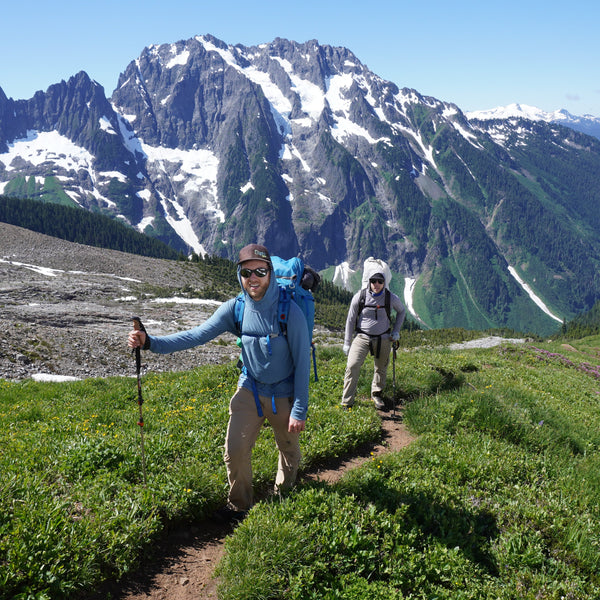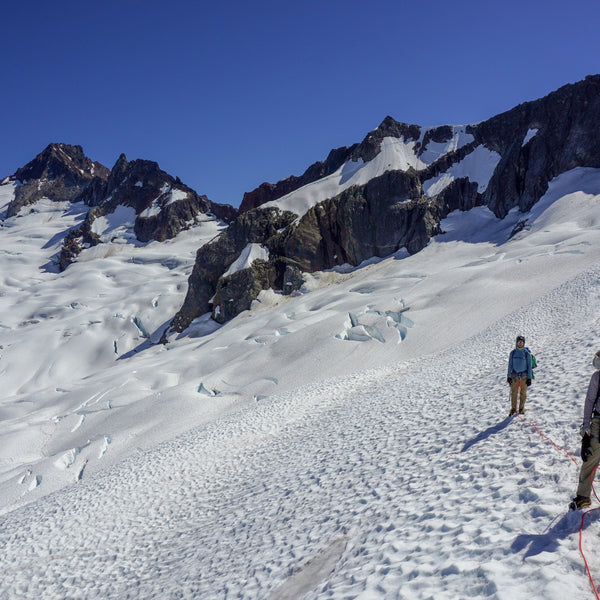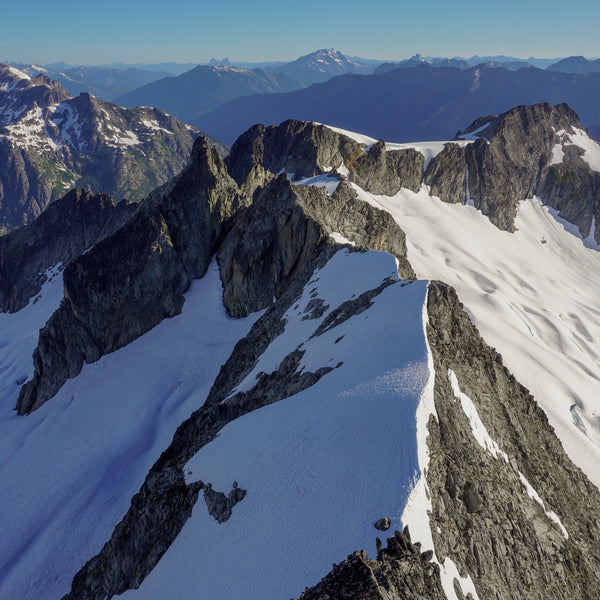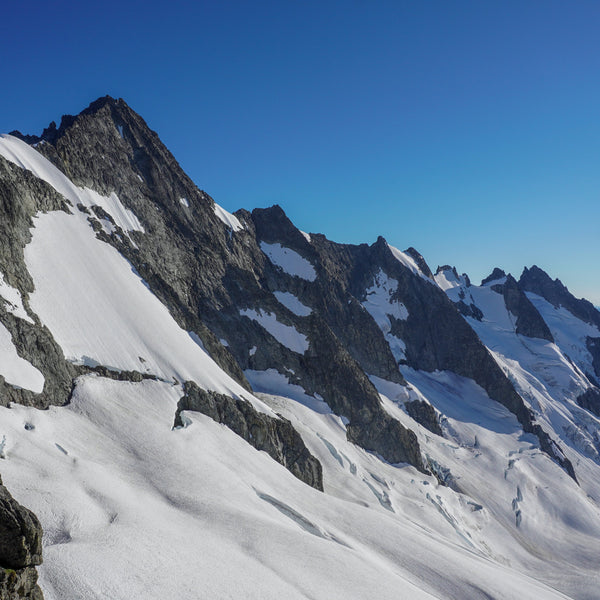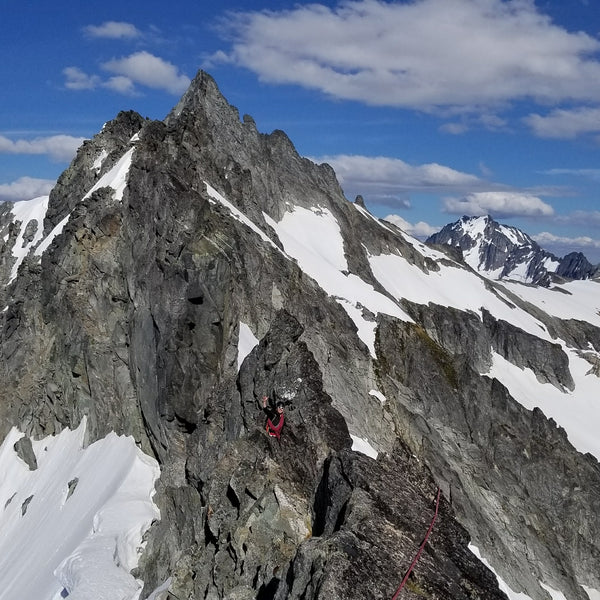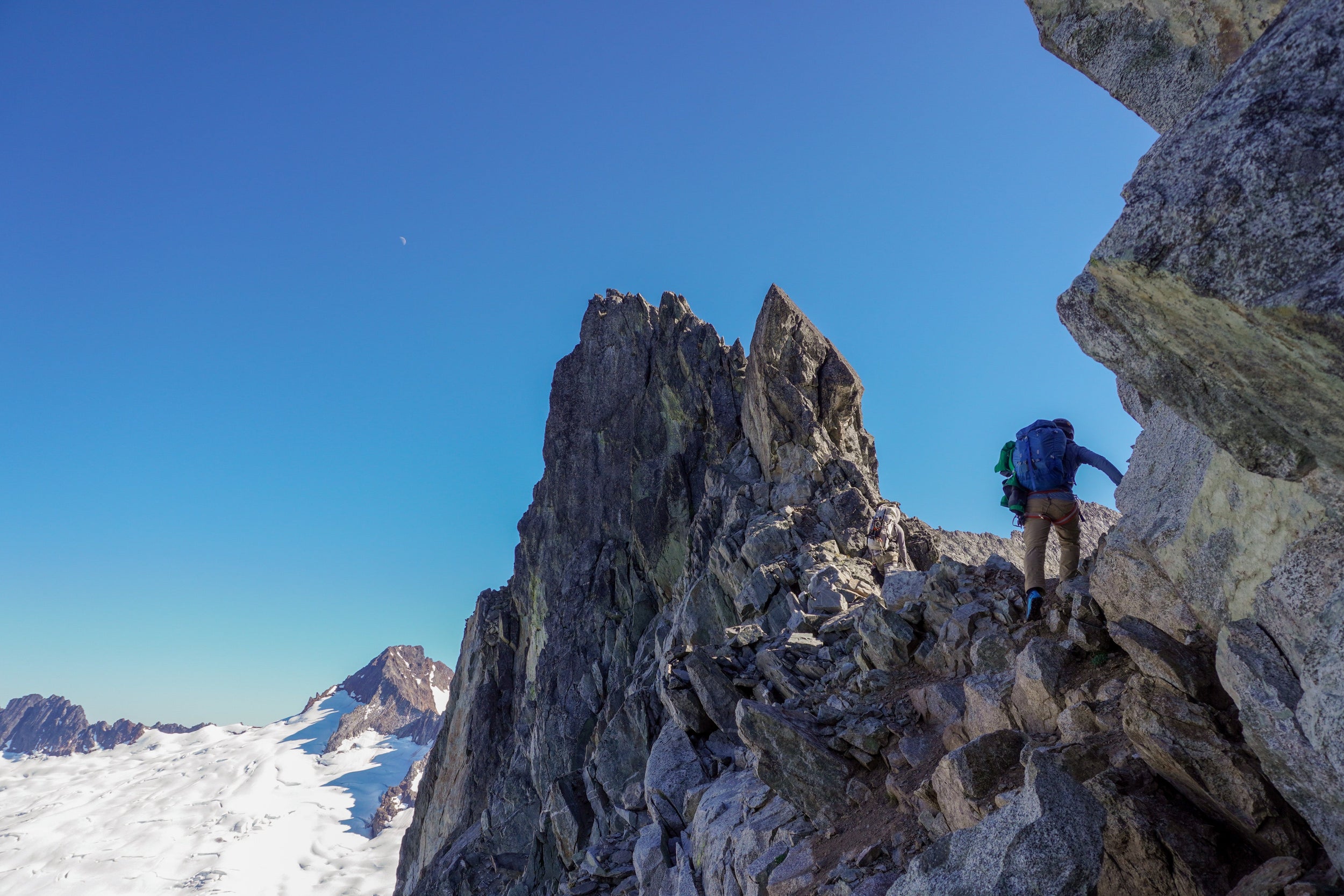
The Torment Forbidden Traverse
We'll tackle the following objectives and skills:
- Push Your Limits - The Torment Forbidden Traverse is a wild and challenging route. It involves summiting Mt Torment, wild and exposed snow and glacier travel, knife-edge rock ridges and over a mile of rocky ridge traversing before summiting Forbidden Peak by the West Ridge.
- The Route - A true Cascadian approach (read: overgrown and rugged) leads climbers to Boston Basin, an iconic rock amphitheater choked with glacial ice that feeds the creeks and lush meadows below. Typically, we will camp our first night in Boston Basin. From camp, the alpine climbing possibilities fan out 180 degrees from Mt Torment to Sahale Peak. Directly above camp looms Forbidden Peak, and from the basin it’s easy to understand how the ominous peak got its name.
- Traverse Attempt -
Mt Torment, on the far western side of Boston Basin, is connected to Forbidden Peak by a rugged granite ridge over a mile long. This ridge is the Torment-Forbidden Traverse, and the climb begins with a summit of Mt Torment. From there we rappel onto the north side of the ridgeline and find a bivy site where we can below the ridge.
Our second day of climbing is a long one. After packing up camp, we traverse snow and steep rock to the base of the West Ridge of Forbidden. It's imperative that teams move quickly in this section because there is a lot of terrain to cover, and the descent is time consuming as well. From the notch, we climb the West Ridge of Forbidden to the summit. - Descent - The descent back to Boston Basin, where the entire climb begins, requires exposed down-climbing and a number of rappels (usually around 6-8 to return to the snow in Boston Basin).
* Non-Reserved Wilderness Dates mean that we do not currently have these dates reserved with wilderness permits. We can usually get reservations for these dates and there are other camping options if we are unable to obtain a wilderness camping permit.
Here's the schedule for your trip:
- Day 1 - Gear Check and Approach to Boston Basin - Gear Check: Meet early for a gear check in Marblemont, WA. Our guides will double check that you have all the right gear for the trip and help you minimize weight, decide on the perfect layers to pack, and choose how much food and water to bring.
Approach to Boston Basin: Roughly 3-4 hours to camp with 3,000’ of elevation gain over 3 miles on a rough climber’s trail. We’ll get to camp, brush up on skills and get to bed early to rest up before our alpine start the next morning. - Day 2 -Summit Mount Torment and Bivy below the Torment-Forbidden Ridge - Mt Torment, on the far western side of Boston Basin, is connected to Forbidden Peak by a rugged granite ridge over a mile long. This ridge is the Torment-Forbidden Traverse, and the climb begins with a summit of Mount Torment. From there we rappel onto the north side of the ridgeline and find a bivy site where we can below the ridge.
- Day 3 - Traverse the Ridgeline from Mount Torment to Forbidden Peak - This is the hardest day of the trip, requiring efficient movement on the ridgeline, up the West Ridge and the descent back to camp. After packing up camp, we traverse snow and steep rock to the base of the West Ridge of Forbidden. It's imperative that teams move quickly in this section because there is a lot of terrain to cover, and the descent is time consuming as well. From the notch, we climb the West Ridge of Forbidden to the summit.
The descent back to Boston Basin, where the entire climb begins, requires exposed down-climbing and a number of rappels (usually around 6-8 to return to the snow in Boston Bason. - Day 4 - Pack Up Camp & Return to the Trailhead - After some much-earned sleep, we pack up camp and head back to the trailhead to finish the trip. The descent usually takes 2.5-3.5 hours.
Here are the skills and fitness you'll need for your course:
- Intermediate Alpine Climbing Experience - Including basic rope skills, experience with belaying, rappelling and technical climbing on 4th and 5th class rock. Depending on the time of year, crampon and ice axe techniques may be required. Looking to build these skills? Join us for an Intro to Mountaineering course!
- Excellent fitness - Able to spend 12-16 continuous hours outside, moving uphill at over 1,000’ per hour for durations of 1-2 hours between breaks. Participants should be able to hike 12-15 miles, climbing 3,000-6,000 vertical feet throughout the course of the day. People with excellent fitness typically have a strenuous workout 4-6 days per week. Be ready for a sufferfest!
Here's what's included with your trip:
- Experienced AMGA Trained Guide
- North Cascades National Park Permit
- Ropes & Gear
- SlingFin Tent
- Stove & Fuel
- Group Safety Gear - your guide will be equipped with a first aid kit
- Wag Bags - for human waste disposal in with compliance 'Leave No Trace' principles
- Meals
- Transportation
- Personal Mountaineering Gear - ice axe, crampons, climbing harness
- Guide Gratuities
North Cascades Alpine Climbing Gear List
- Mountaineering Gear (ice ax, crampon, harness) - Come prepared with your own gear or rent from Blackbird
- Other Mountaineering Gear (sleeping bag, pad, etc.) - Come prepared with your own gear or rent from:
Know Before you go

PRIVATE PROGRAMS
- Custom Scheduling: Choose your dates and plan around your availability.
- Tailored Experiences: Itineraries and objectives are adjusted to suit your goals, experience, and fitness.
- Cost-Effective for Most Large Groups: Private programs are typically more cost-effective for groups of 3 or more.
- Flexibility Comes at a Price: For groups of 1-2, private programs are generally more expensive.
- AIARE Courses: AIARE course pricing is based on a group of 6. Running these as a private program with fewer than 6 participants will increase the per-person cost.
SCHEDULED PROGRAMS
- Fixed Dates & Costs: Scheduled programs have set dates, itineraries, objectives, and pricing.
- Great for Solo or Small Groups: Ideal for individuals or small groups looking to share costs with others.
- Affordable for 1-2 People: Scheduled programs are typically less expensive for groups of 1-2.
- Less Flexibility: Dates fill quickly, and group programs require adapting to the skill level and pace of all participants
- Group Atmosphere: Meet others with similar interests and make some new backcountry buddies!
Note: Any scheduled program can also be run as a private program with customized dates and rates.
Both options offer exceptional guiding and experiences. Choose what works best for you!
Day 1 - Gear Check and Approach to Boston Basin
Gear Check: Meet early for a gear check in Marblemont, WA. Our guides will double check that you have all the right gear for the trip and help you minimize weight, decide on the perfect layers to pack, and choose how much food and water to bring.
Approach to Boston Basin: Roughly 3-4 hours to camp with 3,000’ of elevation gain over 3 miles on a rough climber’s trail. We’ll get to camp, brush up on skills and get to bed early to rest up before our alpine start the next morning.
Day 2 - Summit Mt Torment and Bivy below the Torment-Forbidden Ridge
Day 3 - Traverse the Ridgeline from Mt Torment to Forbidden Peak, Climb Forbidden and descend to Boston Basin
This is the hardest day of the trip, requiring efficient movement on the ridgeline, up the West Ridge and the descent back to camp.
Day 3 - Return to the trailhead
After some much-earned sleep, we pack up camp and head back to the trailhead to finish the trip. The descent usually takes 2.5-3.5 hours.
We'll tackle the following objectives and skills:
- Push Your Limits - The Torment Forbidden Traverse is a wild and challenging route. It involves summiting Mt Torment, wild and exposed snow and glacier travel, knife-edge rock ridges and over a mile of rocky ridge traversing before summiting Forbidden Peak by the West Ridge.
- The Route - A true Cascadian approach (read: overgrown and rugged) leads climbers to Boston Basin, an iconic rock amphitheater choked with glacial ice that feeds the creeks and lush meadows below. Typically, we will camp our first night in Boston Basin. From camp, the alpine climbing possibilities fan out 180 degrees from Mt Torment to Sahale Peak. Directly above camp looms Forbidden Peak, and from the basin it’s easy to understand how the ominous peak got its name.
- Traverse Attempt -
Mt Torment, on the far western side of Boston Basin, is connected to Forbidden Peak by a rugged granite ridge over a mile long. This ridge is the Torment-Forbidden Traverse, and the climb begins with a summit of Mt Torment. From there we rappel onto the north side of the ridgeline and find a bivy site where we can below the ridge.
Our second day of climbing is a long one. After packing up camp, we traverse snow and steep rock to the base of the West Ridge of Forbidden. It's imperative that teams move quickly in this section because there is a lot of terrain to cover, and the descent is time consuming as well. From the notch, we climb the West Ridge of Forbidden to the summit. - Descent - The descent back to Boston Basin, where the entire climb begins, requires exposed down-climbing and a number of rappels (usually around 6-8 to return to the snow in Boston Basin).
* Non-Reserved Wilderness Dates mean that we do not currently have these dates reserved with wilderness permits. We can usually get reservations for these dates and there are other camping options if we are unable to obtain a wilderness camping permit.
Here's the schedule for your trip:
- Day 1 - Gear Check and Approach to Boston Basin - Gear Check: Meet early for a gear check in Marblemont, WA. Our guides will double check that you have all the right gear for the trip and help you minimize weight, decide on the perfect layers to pack, and choose how much food and water to bring.
Approach to Boston Basin: Roughly 3-4 hours to camp with 3,000’ of elevation gain over 3 miles on a rough climber’s trail. We’ll get to camp, brush up on skills and get to bed early to rest up before our alpine start the next morning. - Day 2 -Summit Mount Torment and Bivy below the Torment-Forbidden Ridge - Mt Torment, on the far western side of Boston Basin, is connected to Forbidden Peak by a rugged granite ridge over a mile long. This ridge is the Torment-Forbidden Traverse, and the climb begins with a summit of Mount Torment. From there we rappel onto the north side of the ridgeline and find a bivy site where we can below the ridge.
- Day 3 - Traverse the Ridgeline from Mount Torment to Forbidden Peak - This is the hardest day of the trip, requiring efficient movement on the ridgeline, up the West Ridge and the descent back to camp. After packing up camp, we traverse snow and steep rock to the base of the West Ridge of Forbidden. It's imperative that teams move quickly in this section because there is a lot of terrain to cover, and the descent is time consuming as well. From the notch, we climb the West Ridge of Forbidden to the summit.
The descent back to Boston Basin, where the entire climb begins, requires exposed down-climbing and a number of rappels (usually around 6-8 to return to the snow in Boston Bason. - Day 4 - Pack Up Camp & Return to the Trailhead - After some much-earned sleep, we pack up camp and head back to the trailhead to finish the trip. The descent usually takes 2.5-3.5 hours.
Here are the skills and fitness you'll need for your course:
- Intermediate Alpine Climbing Experience - Including basic rope skills, experience with belaying, rappelling and technical climbing on 4th and 5th class rock. Depending on the time of year, crampon and ice axe techniques may be required. Looking to build these skills? Join us for an Intro to Mountaineering course!
- Excellent fitness - Able to spend 12-16 continuous hours outside, moving uphill at over 1,000’ per hour for durations of 1-2 hours between breaks. Participants should be able to hike 12-15 miles, climbing 3,000-6,000 vertical feet throughout the course of the day. People with excellent fitness typically have a strenuous workout 4-6 days per week. Be ready for a sufferfest!
Here's what's included with your trip:
- Experienced AMGA Trained Guide
- North Cascades National Park Permit
- Ropes & Gear
- SlingFin Tent
- Stove & Fuel
- Group Safety Gear - your guide will be equipped with a first aid kit
- Wag Bags - for human waste disposal in with compliance 'Leave No Trace' principles
- Meals
- Transportation
- Personal Mountaineering Gear - ice axe, crampons, climbing harness
- Guide Gratuities
North Cascades Alpine Climbing Gear List
- Mountaineering Gear (ice ax, crampon, harness) - Come prepared with your own gear or rent from Blackbird
- Other Mountaineering Gear (sleeping bag, pad, etc.) - Come prepared with your own gear or rent from:
the blackbird difference
We’re here to help. Our FAQs or Gear Lists might have the information you’re seeking. But If you’re not finding the information you need, we’d be happy to help!
